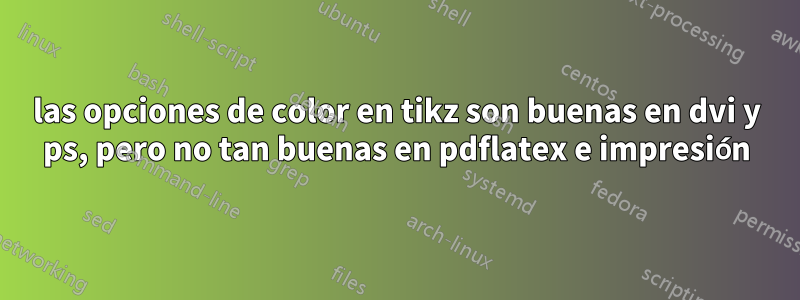
Utilizo tikz para producir gráficos y luego tengo algunas partes sombreadas en negro y otras en gris. Los gráficos se ven bien en DVI y PS y la impresión también es buena con estos archivos. Pero cuando uso pdflatex para producir el archivo en PDF, las partes sombreadas no se ven tan negras o grises como en dvi y ps. Adjunto mi código LaTeX y la imagen en pdf. ¿Por qué pasó esto?
\documentclass[11pt, oneside, A4paper,final,leqno]{article}
\usepackage{amsmath, amssymb, latexsym, amscd, amsthm}
\usepackage[utf8]{vietnam}
\usepackage{graphics}
\usepackage{tikz}
\usepackage{multicol}
\usepackage{indentfirst}
\usepackage[modulo,left, displaymath]{lineno}
\renewcommand\linenumberfont{\normalfont\bfseries\small }
\usepackage{eurosans}
\usepackage{enumerate}
\usepackage{amsfonts}
\usepackage{curves}
%\usepackage{xcolor}
\usepackage{graphics, graphpap}
\usepackage{pstricks}
\usepackage{pst-eps}
\usepackage{makeidx}
\makeindex
\renewcommand{\thefootnote}{}
\usepackage{pgf,tikz}
\usepackage[left=1.5cm,top=1.8245cm,right=1.85cm,bottom=1.69cm,bindingoffset=0.05cm]{geometry}
\usepackage{pst-coil}
\begin{document}
\subsection*{APMOPS 2014 \rule{4.2cm}{.4pt}}
\begin{enumerate}[\scalebox{1.21}{\bf\arabic{enumi}.}]
\item Find the value of $29999+2999+299+29+9$.
\item \parbox[t]{4.565in}{ $ABCD$ is a parallelogram. $P, Q, R,$ and $S$ are the midpoints of the four sides of the parallelogram. If the area of the shaded region is 20 cm$^2$, find the area of the parallelogram $ABCD$.}
\hspace{1pt}
\raisebox{-38pt}[10pt]{\setlength{\unitlength}{1pt}
\begin{tikzpicture}
\tikzset{scale=.62}
\draw (3,3) -- (7,3) -- (6,1) -- (2,1) -- cycle;
\fill[color=black,fill=black,fill opacity=0.1] (3.4,2.2) -- (5.2,2.6) -- (5.6,1.8) -- (3.8,1.4) -- cycle;
\draw (6,1)-- (5,3);
\draw (3,3)-- (4,1);
\draw (2,1)-- (6.5,2);
\draw (7,3)-- (2.5,2);
\begin{scriptsize}
\draw[color=black] (2.86,3.34) node {$A$};
\draw[color=black] (7.16,3.28) node {$B$};
\draw[color=black] (6.43,1.02) node {$C$};
\draw[color=black] (1.66,1.1) node {$D$};
\draw[color=black] (5.16,3.28) node {$P$};
\draw[color=black] (6.764,1.82) node {$Q$};
\draw[color=black] (4.24,1.2) node {$R$};
\draw[color=black] (2.28,2.28) node {$S$};
\end{scriptsize}
\end{tikzpicture}}
\item Jane added up all the digits of the whole number
\[\underbrace{3\times 3\times 3\times \cdots \times 3}_{\text{product of 2012 of digits 3}},\]
and obtained a new number $N_1$. She then added up all the digits of $N_1$ and obtained another number $N_2$. She continued doing this until she obtained a single digit number. Find the value of this new number.
\item \parbox[t]{4.565in}{The diagram shows three circles of different diameters. The circumference of the smallest circle passes through the center of the middle circle and the circumference of the middle circle passes through the centre of the largest circle. Find the ratio of the shaded area to the unshaded area.
}
\hspace{1pt}
\raisebox{-62pt}[10pt]{\setlength{\unitlength}{1pt}
\begin{tikzpicture}
\tikzset{scale=.3025182}
%\draw(4,1) circle (8cm);
\draw(8,1) circle (4cm);
\draw(10,1) circle (2cm);
\draw(11,1) circle (1cm);
\fill[color=black,fill=gray,fill opacity=0.1](8,1) circle (4cm);
\fill[color=black,fill=white,fill opacity=0.1](10,1) circle (2cm);
\fill[color=black,fill=gray,fill opacity=0.1](11,1) circle (1cm);
\end{tikzpicture}}
\end{enumerate}
\end{document}

Respuesta1
Tienes
\fill[color=black,fill=black,fill opacity=0.1]
con fill opacityde 0,1 --- es decir 10%. Entonces, una mancha negra sobre una figura dará como resultado un 10% de negro y un 90% de lo que está debajo.
En Ghostscript dviy psa través de él, probablemente tendrá un relleno negro porque el controlador no admite transparencia...
Prueba con fill opacity=1.
Del apartado 21.2 del manual (v.2.10-CVS):
/tikz/draw opacity= value (no default)Esta opción establece "qué tan transparentes" deben ser las líneas. Un valor de 1 significa “totalmente opaco” o “nada transparente”, un valor de 0 significa “totalmente transparente” o “invisible”. Un valor de 0,5 produce líneas semitransparentes. Tenga en cuenta que cuando utiliza PostScript como formato de salida, esta opción solo funciona con versiones recientes de Ghostscript.
...y algo similar para fill opacity.


